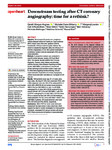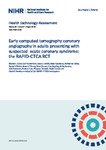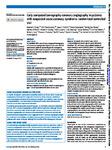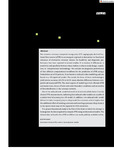Downstream testing after CT coronary angiography: time for a rethink?
| dc.contributor.author | Morgan-Hughes, G | |
| dc.contributor.author | Williams, MC | |
| dc.contributor.author | Loudon, M | |
| dc.contributor.author | Roobottom, CA | |
| dc.contributor.author | Veitch, A | |
| dc.contributor.author | Van Lingen, R | |
| dc.contributor.author | Holloway, B | |
| dc.contributor.author | Bellenger, N | |
| dc.contributor.author | Schmitt, M | |
| dc.contributor.author | Bull, R | |
| dc.date.accessioned | 2021-09-20T12:50:15Z | |
| dc.date.issued | 2021-02-23 | |
| dc.identifier.issn | 2053-3624 | |
| dc.identifier.issn | 2053-3624 | |
| dc.identifier.other | e001597 | |
| dc.identifier.uri | http://hdl.handle.net/10026.1/17867 | |
| dc.description.abstract |
<jats:sec><jats:title>Objective</jats:title><jats:p>We surveyed UK practice and compliance with the National Institute for Health and Care Excellence (NICE) ‘recent-onset chest pain’ guidance (Clinical Guideline 95, 2016) as a service quality initiative. We aimed to evaluate the diagnostic utility and efficacy of CT coronary angiography (CTCA), NICE-guided investigation compliance, invasive coronary angiography (ICA) use and revascularisation.</jats:p></jats:sec><jats:sec><jats:title>Methods</jats:title><jats:p>A prospective analysis was conducted in nine UK centres between January 2018 and March 2020. The reporter decided whether the CTCA was diagnostic. Coronary artery disease was recorded with the Coronary Artery Disease–Reporting and Data System (CAD-RADS). Local electronic records and picture archiving/communication systems were used to collect data regarding functional testing, ICA and revascularisation. Duplication of coronary angiography without revascularisation was taken as a surrogate for ICA overuse.</jats:p></jats:sec><jats:sec><jats:title>Results</jats:title><jats:p>5293 patients (mean age, 57±12 years; body mass index, 29±6 kg/m²; 50% men) underwent CTCA, with a 96% diagnostic scan rate. 618 (12%) underwent ICA, of which 48% (298/618) did not receive revascularisation. 3886 (73%) had CAD-RADS 0–2, with 1% (35/3886) undergoing ICA, of which 94% (33/35) received ICA as a second-line test. 547 (10%) had CAD-RADS 3, with 23% (125/547) undergoing ICA, of which 88% (110/125) chose ICA as a second-line test, with 26% (33/125) leading to revascularisation. For 552 (10%) CAD-RADS 4 and 91 (2%) CAD-RADS 5 patients, ICA revascularisation rates were 64% (221/345) and 74% (46/62), respectively.</jats:p></jats:sec><jats:sec><jats:title>Conclusions</jats:title><jats:p>While CTCA for recent-onset chest pain assessment has been shown to be a robust test, which negates the need for further investigation in three-quarters of patients, subsequent ICA overuse remains with almost half of these procedures not leading to revascularisation.</jats:p></jats:sec> | |
| dc.format.extent | e001597-e001597 | |
| dc.format.medium | ||
| dc.language | en | |
| dc.language.iso | en | |
| dc.publisher | BMJ Publishing Group | |
| dc.subject | CT angiography | |
| dc.subject | chest pain | |
| dc.subject | coronary angiography | |
| dc.subject | diagnostic imaging | |
| dc.subject | Adolescent | |
| dc.subject | Adult | |
| dc.subject | Aged | |
| dc.subject | Aged, 80 and over | |
| dc.subject | Computed Tomography Angiography | |
| dc.subject | Coronary Angiography | |
| dc.subject | Coronary Artery Disease | |
| dc.subject | Electrocardiography | |
| dc.subject | Female | |
| dc.subject | Follow-Up Studies | |
| dc.subject | Humans | |
| dc.subject | Male | |
| dc.subject | Middle Aged | |
| dc.subject | Predictive Value of Tests | |
| dc.subject | Prospective Studies | |
| dc.subject | Young Adult | |
| dc.title | Downstream testing after CT coronary angiography: time for a rethink? | |
| dc.type | journal-article | |
| dc.type | Journal Article | |
| dc.type | Multicenter Study | |
| plymouth.author-url | https://www.ncbi.nlm.nih.gov/pubmed/33622963 | |
| plymouth.issue | 1 | |
| plymouth.volume | 8 | |
| plymouth.publication-status | Published | |
| plymouth.journal | Open Heart | |
| dc.identifier.doi | 10.1136/openhrt-2021-001597 | |
| plymouth.organisational-group | /Plymouth | |
| plymouth.organisational-group | /Plymouth/Faculty of Health | |
| plymouth.organisational-group | /Plymouth/Faculty of Health/Peninsula Medical School | |
| plymouth.organisational-group | /Plymouth/REF 2021 Researchers by UoA | |
| plymouth.organisational-group | /Plymouth/REF 2021 Researchers by UoA/UoA01 Clinical Medicine | |
| plymouth.organisational-group | /Plymouth/REF 2021 Researchers by UoA/UoA01 Clinical Medicine/UoA01 Clinical Medicine | |
| plymouth.organisational-group | /Plymouth/Users by role | |
| plymouth.organisational-group | /Plymouth/Users by role/Academics | |
| dc.publisher.place | England | |
| dcterms.dateAccepted | 2021-02-08 | |
| dc.rights.embargodate | 2021-9-21 | |
| dc.identifier.eissn | 2053-3624 | |
| dc.rights.embargoperiod | Not known | |
| rioxxterms.versionofrecord | 10.1136/openhrt-2021-001597 | |
| rioxxterms.licenseref.uri | http://www.rioxx.net/licenses/all-rights-reserved | |
| rioxxterms.licenseref.startdate | 2021-02-23 | |
| rioxxterms.type | Journal Article/Review |





